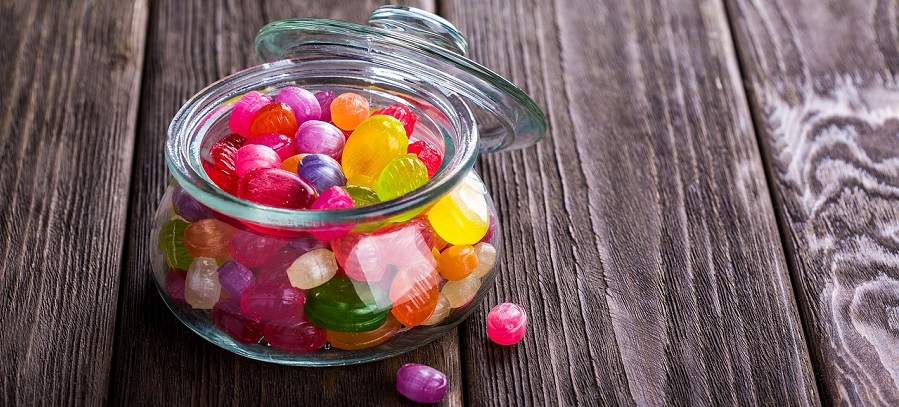Candy, also known as confectionery, is a sweet food that is usually made from sugar or other sweeteners, along with ingredients such as chocolate, fruit, nuts, and other flavorings. The history of candy can be traced back to ancient civilizations, where people made sweets using honey and fruits.
Candy making is a complex process that typically involves melting sugar and other ingredients, adding flavorings and colorings, and shaping the candy into various forms. There are different types of candy, including hard candy, chewy candy, gummy candy, chocolate candy, and more.
The packaging of candy plays a key role in consumer purchasing decisions, as it can influence brand perception and product appeal. Many cand makers also focus on marketing their products in a way that ties them to holidays or special occasions.
Overconsumption of candy can have negative impacts on health, as it can contribute to tooth decay, obesity, and other health concerns. Some alternative to traditional candy include sugar-free options, chocolate bars made with alternative sweeteners, and natural or organic cand.
The production of candy can also have negative impacts on the environment, particularly in terms of the use of resources and energy, and the disposal of waste.
What is the most popular type of candy in the US?
The most popular type of candy in the US is chocolate candy. This includes chocolate bars, chocolate covered candy, and chocolate covered nuts. Some of the most popular chocolate candy brands in the US include Hershey's, Mars, Nestle, and Cadbury.
How is candy made?
Candy making is a complex process that typically involves several steps. The specific process depends on the type of candy being made. Below is a general overview of the candy making process:
-
Ingredient preparation: This includes measuring and mixing the ingredients, such as sugar, corn syrup, chocolate, fruit, nuts, and flavorings.
-
Cooking: The ingredients are heated in a kettle or pot to specific temperatures. Hard candy is cooked at higher temperatures than soft candy and chocolates.
-
Mixing and forming: The cooked mixture is poured into a large mixing machine and agitated, while it cools and thickens. Depending on the desired end product, it can be poured into molds, dropped onto a conveyor belt, or hand-rolled.
-
Cooling: The candy is then cooled and solidified.
-
Finishing: The candy is then polished, packaged, and inspected for quality before being shipped to stores.
Some cand like chocolates and gummies require additional steps like tempering, coating, and shaping, also some cand like chocolate truffles and filled cand need to be handcrafted.
The candy-making process can be done on a small scale by hand, or on a large scale using industrial equipment. It's a combination of art and science that requires knowledge of ingredients properties and behavior, temperature, and time management.
What are some popular candy brands?
Some popular candy brands include:
- Hershey's
- Mars
- Nestle
- Cadbury
- Reese's
- M&M's
- Skittles
- Snickers
- Starburst
- Haribo
- Lindt
- Ghirardelli
- Ferrero
- Godiva
- Toblerone
- Lindor
- See's Candies
- Ferrero Rocher
- Tootsie Roll
- Jelly Belly
These brands are known for producing a wide range of cand, including chocolate, hard candy, gummy candy, and more. They are popular worldwide, and many of them are household names. Some of them have been around for over a century, which attests to the popularity and quality of their products.
What are some common ingredients found in candy?
Some common ingredients found in candy include:
-
Sugar: This is the main ingredient in most cand and provides the sweet taste.
-
Corn syrup: This is often used in candy making as a sweetener and to help prevent crystals from forming in the candy.
-
Chocolate: Many cand are made with chocolate, which provides a rich, creamy taste and texture.
-
Fruit: Many cand include fruit flavors or pieces of real fruit, such as strawberries, oranges, and lemons.
-
Nuts: Many cand are made with nuts, such as almonds, peanuts, and hazelnuts.
-
Milk and cream: These ingredients are often used in chocolate candy and can be used to make creamy fillings.
-
Artificial flavorings and colorings: These ingredients are used to give candy a specific taste or color.
-
Emulsifiers: These are ingredients that keep the chocolate smooth and prevent it from separating.
-
Starch: Some cand use starch to help form the candy and to make it more stable.
-
Gum arabic, gelatin, pectin: These ingredients are used to make gummy cand and chewy cand.
-
Glucose, fructose, and dextrose: These ingredients can be used as a sweeteners and to help control the texture of the candy.
The specific ingredients used in a candy will vary depending on the type of candy being made.
What is the difference between hard candy and chewy candy?
Hard candy and chewy candy are two different types of candy that are distinguished by their texture and ingredients.
Hard candy is made by heating sugar and corn syrup to high temperatures, and then cooling and shaping the mixture into a hard, crystalline form. It can be flavored with various ingredients and it is often brittle and can be sucked or lollipops. Hard candy tends to have a longer shelf life than other types of candy, as it does not melt or become sticky over time. Examples of hard candy include lollipops, peppermints, and hard fruit cand.
Chewy candy, on the other hand, is made by heating sugar, corn syrup, and ingredients like gelatin, pectin, or gum arabic. These ingredients give the candy a soft, chewy texture, which is why it's called chewy candy. Examples of chewy candy include gummy bears, taffy, and caramels. Chewy candy tends to be more delicate and can melt or become sticky if not stored properly.
In summary, the main difference between hard candy and chewy candy is their texture, Hard candy is hard and brittle, while chewy candy is soft and chewy. The ingredients used to make the cand are also different, hard candy is mainly made of sugar and corn syrup, while chewy candy needs additional ingredients like pectin, gum arabic or gelatin.
How does candy relate to holidays and special occasions?
Candy is often associated with holidays and special occasions because it is a common treat that people enjoy during these times. Many cand makers create special packaging and flavors for holidays such as Christmas, Valentine's Day, Easter and Halloween.
For example, during Christmas, many cand makers create special Christmas-themed packaging for their chocolates and cand, such as Christmas trees, snowmen, and Santa Claus figures. They also create special holiday flavors like gingerbread, peppermint, and eggnog.
Valentine's Day is another occasion where cand plays a significant role, as cand and chocolate are traditional gifts for loved ones. Many cand makers create special heart-shaped boxes of chocolates and cand for this occasion.
Easter is another holiday where candy is popular, where brands create cand shaped like Easter eggs, bunnies, and other Easter-themed shapes.
Halloween is also a popular holiday where candy plays a big role. Candy is given out to trick-or-treaters, and many people also use candy as decorations for Halloween parties.
In addition to holidays, candy is also associated with special occasions such as birthdays, weddings, and graduations. Candies can be used to make beautiful and delicious cake decorations, favors, and table settings. It's also a common way to say congratulations or thank you.
Overall, candy has become an integral part of holidays and special occasions as it is a sweet treat that brings joy and happiness to people of all ages.
How does the texture of candy affect taste perception?
The texture of candy can have a significant impact on taste perception.
For example, a crunchy texture can enhance the perception of sweetness and can also provide a satisfying sensation when bitten. Hard cand like lollipops and mints are often enjoyed for their texture as well as the flavor.
Chewy cand like gummies, caramels, and taffy have a slower release of flavor and sweetness, which can prolong the taste experience. Chewy cand can also enhance the perception of fruit or other flavors, as the chewiness allows the flavor to linger in the mouth.
Smooth and creamy textures, as found in chocolate and creamy fillings, can provide a rich and indulgent taste experience. The smoothness can also enhance the perception of creaminess, which can complement the sweetness and flavors of the candy.
The texture also affects the release of flavors, for example, hard candy dissolves slowly in the mouth, which allows the flavors to be released over time. Chewy candy, on the other hand, can release the flavors more quickly, which can give the impression of a stronger flavor.
In conclusion, the texture of candy plays an important role in the taste perception of candy. Different textures can enhance the perception of sweetness, flavor, creaminess and can prolong the taste experience. The texture can also help to release the flavors in different ways, which can affect how the candy tastes.
What are some common health concerns associated with consuming too much candy?
Consuming too much candy can have negative effects on health. Some common health concerns associated with overconsumption of candy include:
-
Tooth decay: Candy is high in sugar, which can lead to tooth decay if consumed in large amounts. The stickiness of some candy can also make it more likely to stick to teeth and cause damage.
-
Weight gain: Candy is high in calories and consuming too much can contribute to weight gain and obesity.
-
Diabetes: Consuming too much sugar can increase the risk of developing type 2 diabetes, as it can cause a spike in blood sugar levels.
-
Metabolic Syndrome: Consuming too much candy can contribute to the development of metabolic syndrome, a group of risk factors that increase the risk of heart disease and diabetes.
-
Nutrient deficiencies: Consuming too much candy can displace other more nutritious foods from the diet, leading to nutrient deficiencies.
-
Allergies and intolerances: Some candy contains ingredients that can cause allergies or intolerances in some individuals, such as peanuts, tree nuts, gluten, and dairy.
-
Addictive: Consuming too much candy can lead to addiction and dependence on sugar, which can make it hard to stop eating candy and lead to overeating.
It's important to note that consuming candy in moderation can be part of a balanced diet, and that consuming sugar in moderation is not harmful. But consuming too much candy can have negative effects on health. It's important to be mindful of how much candy is consumed and to balance it with other nutritious foods.


